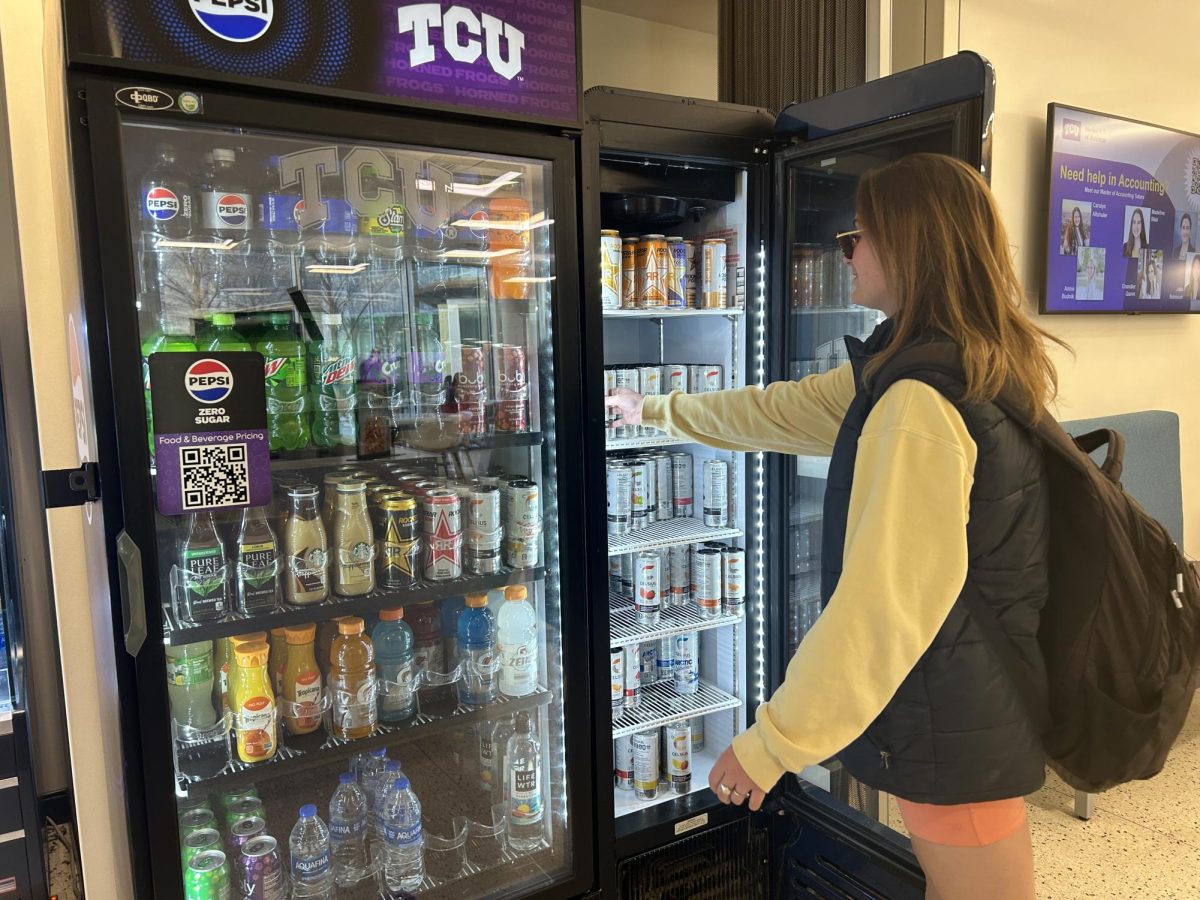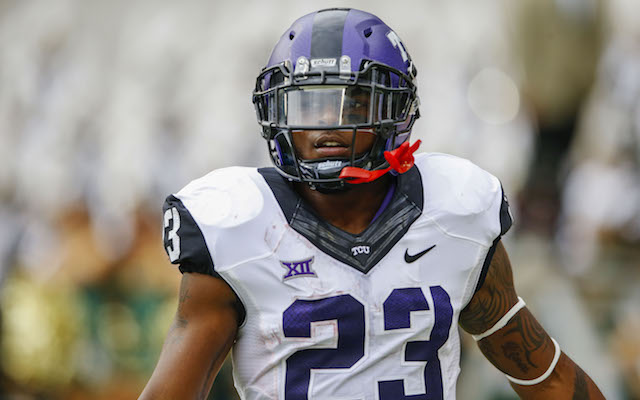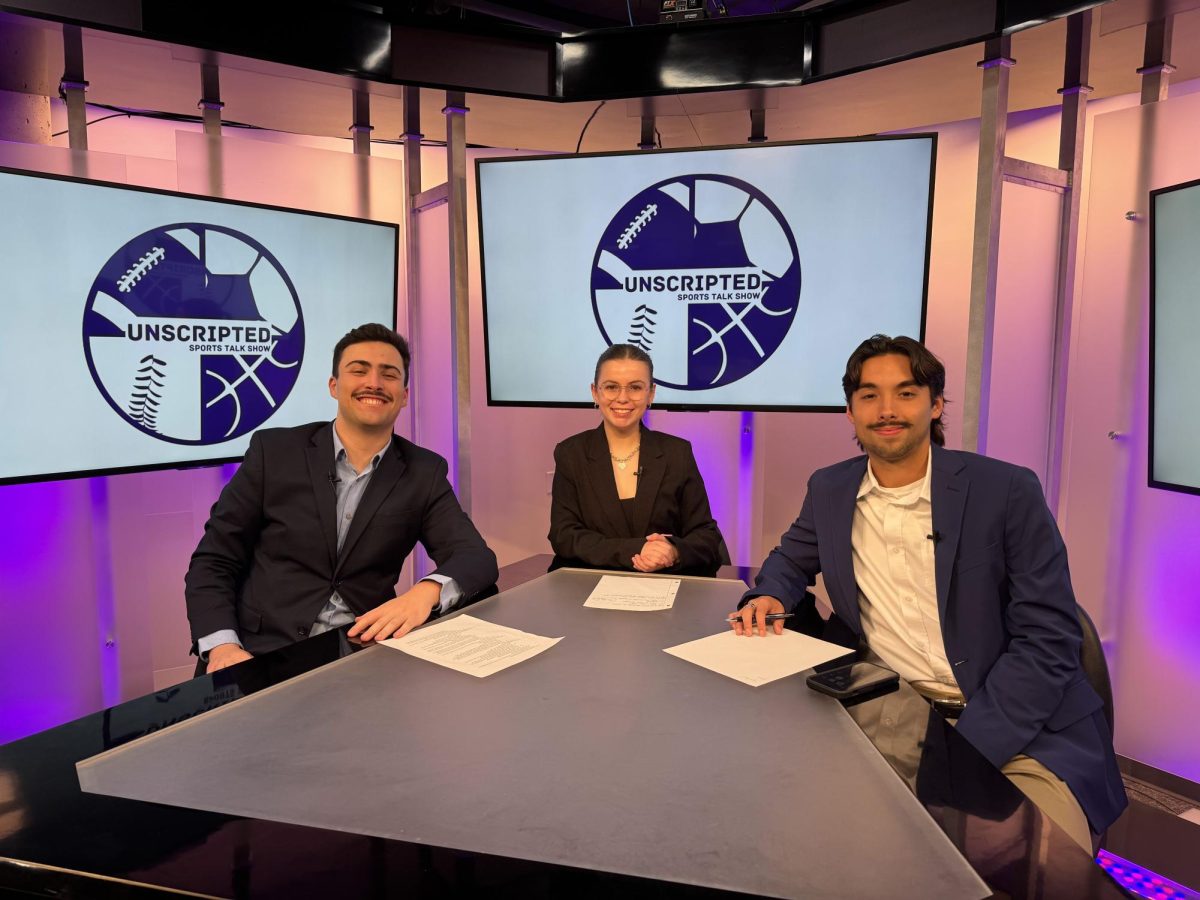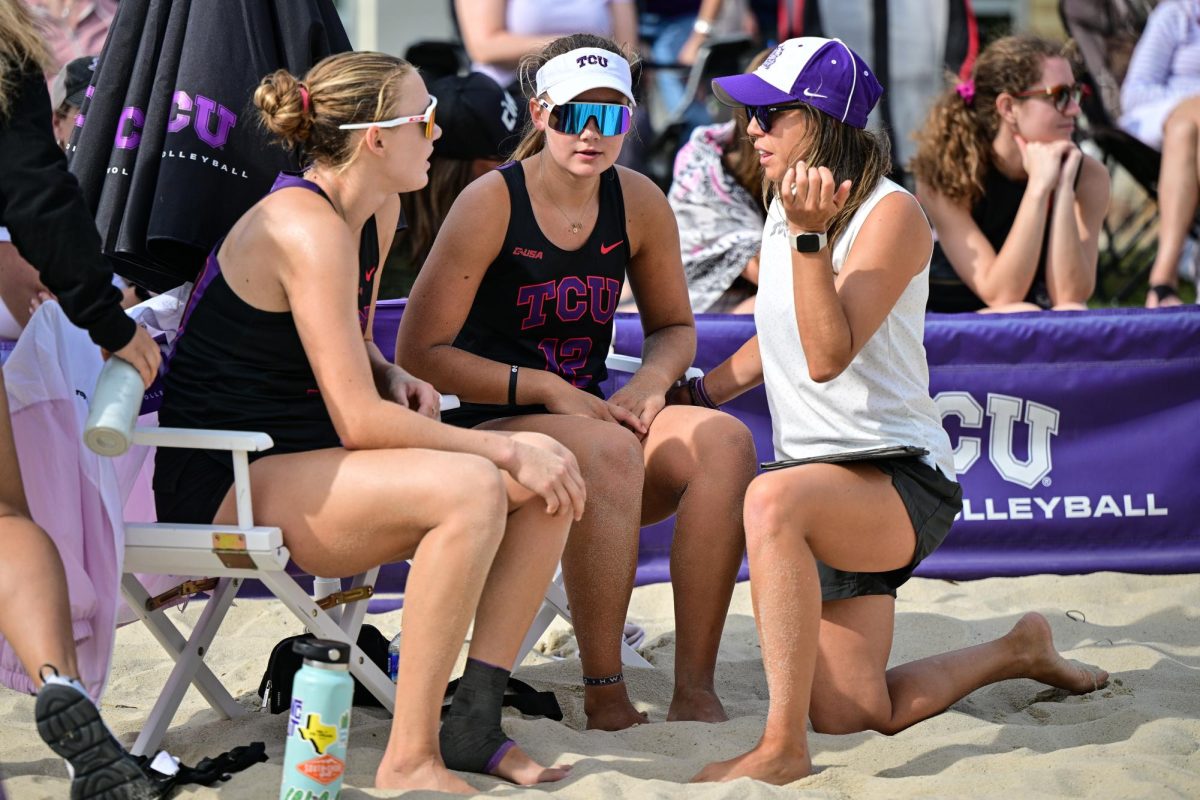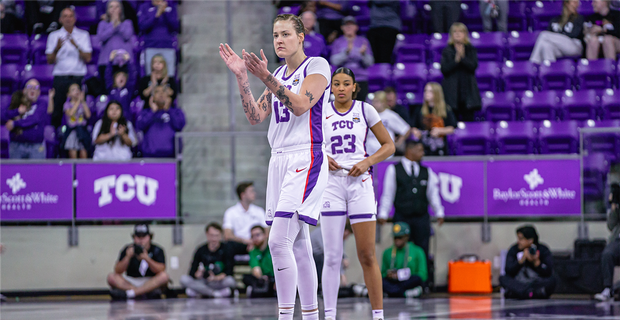This story first appeared in IMAGE Magazine.
Facing third-and-one in opposing territory, TCU called a play for its star running back, B.J. Catalon.
The Horned Frogs trailed by two with less than a minute remaining against West Virginia on Nov. 1, 2014, and they were trying to set up a game-winning field goal. Quarterback Trevone Boykin took the snap out of the pistol formation and handed the ball to Catalon, who cut left and squeezed between the guard and the tackle for two yards. First down.
Catalon had kept the Frogs in the game with his running while their passing attack sputtered in the cold weather. He ran the ball 20 times for 105 yards and two touchdowns.
The 20th carry was the last of his college career.
TCU hurried to the line and ran the same play to gain a few more yards for kicker Jaden Oberkrom. Boykin handed off to Catalon, who cut left again, this time going around the left tackle. Mountaineer safety Karl Joseph read the play and flew forward as Catalon came around the edge.
“I didn’t even see him,” Catalon said.
Joseph hit him at full speed. Catalon’s head snapped back as the safety flattened him. The junior had suffered a concussion, his third since arriving at TCU and the one that ended his days as a college football player.
Career-ending concussions are becoming more common as players, coaches and doctors have become more aware of the long-term effects of head trauma. Yet some athletes still hide concussions for fear of not being able to play the game they love.
College football programs are doing more in recent years to protect players and keep them off the field when they suffer concussions. The major conferences now have a committee to approve teams’ procedures for handling such injuries. Some believe more should be done to hold programs accountable to those standards.
Coaches and players are now more educated about the risks concussions pose. This awareness led to a significant increase in the number of players who reportedly suffered concussions among the major conferences last season – 128 compared to 78 a year earlier.
Meanwhile, some players have made the difficult choice to walk away from football. They decided the risks for their long-term health were not worth trying to keep playing, even if that means giving up the game they love.
“My Feet Weren’t Under Me”
Catalon stayed on his back for a moment after the hit. He felt dizzy and dazed, like he had just taken a punch. He managed to roll over, push to his feet and stagger to the sideline.
“My feet weren’t under me,” he said, and when he got off the field he immediately lay down as the athletic trainers examined him. It was something he had experienced before.
He suffered two concussions in 2013. Each one sidelined him for a week as he went through TCU’s concussion protocol. The policy requires that a player be symptom-free before starting the process of returning to play.
Catalon was able to sit up after a moment and join his teammates on the sideline as they watched Oberkrom’s field goal sail through to win the game. After the game, he said he felt fine.
But this third concussion was different. His symptoms weren’t going away as quickly. He suffered migraines that made it difficult to be around bright lights or loud noises, which kept him from traveling with the team.
He missed TCU’s next two games against Kansas State and Kansas. He expected to return for the Frogs’ Thanksgiving matchup with Texas, nearly four weeks after his concussion. But when the Frogs went to Austin, Catalon stayed home, still trying to recover.
That can be the struggle for players who have had multiple concussions. Research shows that symptoms typically subside in seven to 10 days for most concussions. The effects can linger for much longer, however, especially in athletes who have previously suffered head trauma.
Former Boston College safety Christian Lezzer retired last season after sustaining five concussions over his football career, three in high school and two in 2015.
Lezzer sustained his first concussion of 2015 during two-a-days. But he didn’t report his symptoms to athletic trainers because he thought he could play through them.
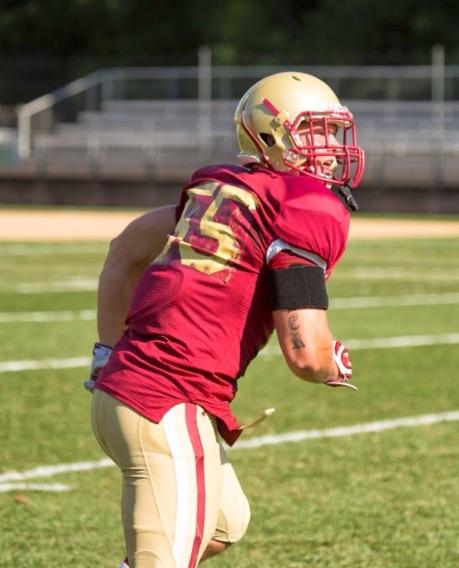
When he suffered another concussion during practice in September, he couldn’t hide the pain anymore. His symptoms – feeling in a fog mentally, memory loss – were so severe they interfered with his life outside football too. And they were not going away.
“My memory was way off,” Lezzer said. “My concentration was way off. I couldn’t remember things. I remember I was walking to class one time, and I didn’t remember what I was doing.”
Lezzer reported his symptoms to the athletic trainers and revealed he thought he may have suffered another concussion earlier in the season. He sat out of practice while he waited for his symptoms to subside, not knowing when or if he would be able to play again.
Catalon finally returned to practice, but not for long. His migraines returned after one practice because of the strenuous physical activity. The team doctors then decided to make him sit out the rest of the season.
The tailback dealt with mood swings as he missed game after game. His biggest struggle was feeling isolated. He was not practicing, so he was not spending time with his teammates, some of his closest friends. He felt alone. All he wanted was to play, and he couldn’t.
“It was draining,” Catalon said, “because I didn’t understand when I was going to be able to come back – if I was going to be able to come back.”
College football programs have become more cautious in how they handle concussions. They are trying to protect athletes like Catalon, and they are also trying to protect themselves.
Protocols and Pressures
The NCAA is facing lawsuits over how college athletic programs have handled concussions. Some former players are dealing with health issues such as seizures and depression after suffering concussions playing college sports, and they have argued that colleges were negligent in their treatment of athletes with concussions.
In response, the Power 5 conferences in college athletics – the ACC, Big 12, Big Ten, Pac-12 and SEC – voted in January 2015 to establish a Concussion Safety Protocol Committee. All 65 universities in those conferences must submit their athletic program concussion protocols to the committee each year to ensure they comply with the Concussion Safety Protocol Checklist.
The checklist applies to all sports and outlines procedures that programs must follow. For instance, athletes must go through tests to measure their balance and cognitive function before they can practice. Players suspected of having a concussion have to leave the game or practice and take those tests again.
The team medical staff can compare the results to see if there has been any change in the player’s brain function, which would be evidence of a concussion. If a football player is diagnosed with a concussion, he is not allowed to return to competition or practice for the rest of the day.
The player has to pass concussion tests and demonstrate he is symptom-free before he can begin the process of returning to practice and competition. The process starts with light aerobic exercise and progresses to more rigorous activity, then non-contact practice followed by full-contact practice. If the player completes all of those steps and his symptoms do not return, he can be cleared to play, but only a team doctor can make that decision.
These procedures are in place because playing with a concussion can increase the risk of long-term health issues such as chronic traumatic encephalopathy (CTE). CTE can cause dementia, depression and even suicidal behavior. If a player sustains another head injury before fully recovering from a concussion, he can suffer serious brain damage. It can even be fatal.
Some are concerned about enforcement of these protocols. The committee has no power to penalize programs that don’t properly follow protocol. Big 12 commissioner Bob Bowlsby said that’s because some schools don’t want that level of accountability.
“The fact is there are places where coaches are making return-to-play decisions and that’s not right,” Bowlsby told CBS Sports in early 2015. “It’s not right for young people. It’s not right from a competitive standpoint. It’s the wrong approach to it. Those decisions ought to be vested in the hands of medical personnel singularly.”
Bowlsby shares a concern with many that the competitive environment of college athletics could lead teams to jeopardize player safety for a competitive advantage. A 2015 study in the Journal of Athletic Training found that more than half of college athletic trainers and team doctors had been pressured by coaches to clear a player to return from a concussion before that player was ready.
In response to those concerns, the Power 5 voted in January to give school medical officials authority to make the final decision on when an athlete can return after suffering a concussion.
Scott Anderson, head athletic trainer at Oklahoma, represents the Big 12 on the committee. He said he is not concerned that the committee cannot hand down penalties. Every athletic director has to sign an affidavit ensuring compliance with protocol, and athletic trainers and doctors have their own licensing boards to answer to when it comes to how they handle concussions and other injuries.
“We’re already held to a higher standard,” Anderson said. “So quite frankly, the NCAA and its penalties don’t hold my attention, but my licensing and governing bodies do.”
Even as athletic trainers and doctors keep an eye out for injuries, players can still hide their symptoms.
Playing Through the Pain
Lezzer chose to hide his first concussion at Boston College. It would take a lot to keep him from playing. In high school, he once suffered a broken collarbone, a torn labrum and a separated shoulder all in one play. He came back to play the next week.
“I had such a love for the game and wanted to be out there with my teammates,” he said.
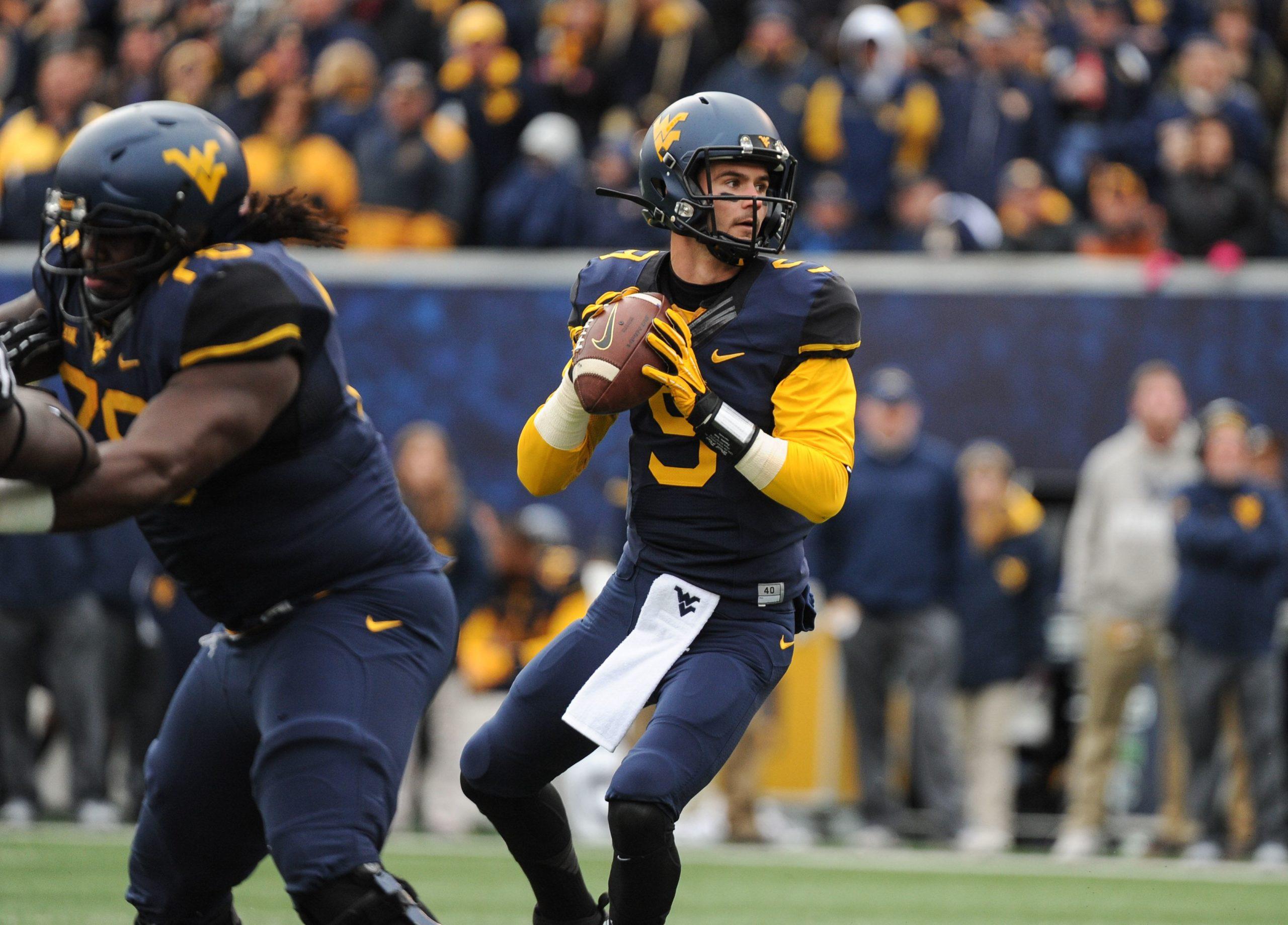
Former West Virginia quarterback Clint Trickett retired from football after the 2014 regular season due to head trauma. He had suffered five concussions over 14 months and hid two from athletic trainers.
“In fairness to our training staff, they didn’t know,” Trickett said when he revealed he played while he had concussions. “I didn’t tell them, so that was on me. If they would have known, they probably would have been more cautious about it, but I was trying to push through it.”
Two weeks after his second concussion in 2013, Catalon returned to play against Kansas State. He slipped and fell while returning a kickoff. He had trouble getting up because he was dizzy, possibly a sign that he still had symptoms, and a teammate had to help him up.
“But it wasn’t so bad that I felt like I had to say something,” Catalon said.
Such is the mindset of many football players. Before they can practice or play, all Power 5 athletes must sign a form acknowledging they have been educated about concussions and they need to report any symptoms they experience. But that can be the last thing on a player’s mind in the heat of a game.
When TCU played Oklahoma in November, Sooner quarterback Baker Mayfield suffered a concussion in the first half of the game from a hit by TCU linebacker Ty Summers.
Summers was ejected from the game for a targeting penalty because he lowered his head and made helmet-to-helmet contact on the play. Mayfield played the rest of the quarter. The athletic trainers checked on Mayfield while he was on the sideline. They removed him from the game after halftime, however, because he admitted he had a headache.
The quarterback said he didn’t like the trainers’ decision to take him out of the game, though he understood they were doing their jobs. Had it been his choice, he said he would have kept playing. He passed concussion tests the day after the game and played the following week against Oklahoma State.
Dr. Matthew Johnson, a professional counselor and sport psychologist who works in the TCU Counseling and Mental Health Center, said players choose to take those risks in part because their brains are still developing. The frontal lobes of the brain, which control decision-making, are still in their adolescent stage until age 25.
“All of us, as we go through that period from 13 to 25, we’re more prone for high-risk behaviors during that time,” Johnson said.
There are many reasons players don’t report symptoms. Lezzer said he was afraid of letting his teammates down. If he didn’t play, what would they think of him?
Mayfield just wanted to keep playing. He had to sit out all of 2014 because of NCAA transfer rules after coming to Oklahoma from Texas Tech. He didn’t want to be on the sideline anymore.
“Guys don’t report stuff because you’re in your spot, and you don’t want to get it taken away,” Mayfield told reporters.
Those are some of the many fears that players deal with when facing any injury, but especially concussions. They may lose a starting position. They may disappoint people. The team may lose if they don’t play. They may not be able to play professionally – or ever again.
Johnson said those fears influence how players handle significant injuries. Their identities can revolve around playing their sport.
“It’s like the death of a relationship,” Johnson said. “Every athlete has a relationship with their sport because they’ve done it for so long.”
Some believe athletes are starting to recognize the need to be open about concussions. While some players choose to hide head trauma, the number of reported concussions is up among the Power 5 overall as coaches and players have become more aware of the dangers of head trauma.
Higher Awareness and Higher Numbers
The number of reported concussions in college football increased significantly in 2015 compared to the previous season.
According to a survey of media reports, 128 players among the Power 5 conferences sustained concussions last season. In 2014, Al Jazeera America reported 78 players suffered concussions among those conferences.
During the 2014 football season, the ACC had 15 reported concussions, according to Al Jazeera America, tied for second-most among the major conferences. The ACC had 40 in 2015, the most of any conference.
That does not necessarily mean more players are getting concussions. Coaches, players and administrators have become more aware of the need to identify them, said Mark Coberly, associate athletic director for sports medicine at Iowa State.
“All of our coaches are educated and they know their responsibilities,” Coberly said. “If they think they have a player that’s exhibiting signs or symptoms, and they notice that, they would let us know.”
Dr. Damond Blueitt, medical director of the Texas Health Ben Hogan Concussion Center, said the rise in reported concussions could also be a result of players and parents knowing more about the dangers of head trauma. He calls it the “fear factor.”
“People are more aware of what repetitive concussions can do,” Blueitt said, “and they’re kind of afraid to get a concussion.”
Blueitt said that high school and college athletes and their parents are starting to report symptoms more because they know those dangers, which are even more serious if they don’t take the time needed to recover.
That extends to teammates and coaches. Coberly said there were multiple instances in 2015 that Cyclone coaches and even players told the athletic training staff a player seemed to have concussion symptoms.
Increased awareness is critical, Coberly said, since doctors and athletic trainers can’t watch every player for symptoms.
In the Power 5, offensive linemen and quarterbacks tied for the most reported concussions. Each position had 19 players who reportedly suffered concussions.
Blueitt said linemen usually suffer more head trauma than any other position. Linemen deal with numerous “sub-concussive” hits because their heads make contact with other players on most plays.
“Most of the time it’s not these knockout plays that you see when a receiver comes across the middle and gets hit from the blind side,” Blueitt said. “But [linemen] do hit every play, either helmet to shoulder pad or helmet to helmet.”
Quarterbacks often suffer concussions because they don’t see hits coming while they stand in the pocket and don’t have time to brace themselves, Blueitt said. With just one quarterback on the field for every five offensive linemen, quarterbacks actually suffer the most concussions per player of any position.
One of those quarterbacks was Syracuse’s A.J. Long. Long was one of two players among Power 5 schools – along with Vanderbilt linebacker Nigel Bowden – who had to stop playing football in 2015 based on doctors’ decisions. Bowden is expected to play again in 2016, Vanderbilt head coach Derek Mason said.
Long was medically disqualified, which means he will not be able to play for the Orange again. He has announced that he plans to transfer and play at another school. He would have to be medically cleared by any program that tries to accept him, which has happened in the past with other players. Former TCU wide receiver Cam White was medically disqualified after multiple concussions. He transferred to Grambling State in order to continue playing.
For some, however, the risks of concussions are enough to make them give up football entirely.
Giving Up the Game
Six players in the Power 5 retired from football in 2015 because of concussions. Two retired in the spring: Michigan offensive lineman Jack Miller and Georgia Tech offensive lineman Nick Brigham. Four more retired because of concussions during the season, including Lezzer, Syracuse defensive end Luke Arciniega, Georgia Tech linebacker Beau Hankins and Oregon State linebacker David Henry.
Lezzer never thought he would end up on that list.
“You play because you love it,” he said. “And to have that ripped away from you, it’s really hard, and it’s hard to grasp. It’s like you’re in denial. You don’t want to let go of that.”
The Boston College training staff talked to Lezzer and his parents about the long-term health risks if he chose to keep playing. His parents were worried, he said, and they were not alone. Members of the Eagles’ coaching staff told him that if he were their son, they would not allow him to play.
He decided to retire from football as a sophomore. He would finish his education at Boston College and go on to a new chapter in his life.
“It’s really, really hard for me to hang it up,” Lezzer said. “But it’s for the best, because in the end it’s just a game. It’s not worth your long-term health.”
Trickett wanted to stay around the game by going into coaching. He is now an assistant football coach at East Mississippi Community College.
“The more and more I think about it, I’m like, well, what I’m getting into, I probably need to have a couple brain cells left,” Trickett joked at his retirement announcement, “so it is for the best.”
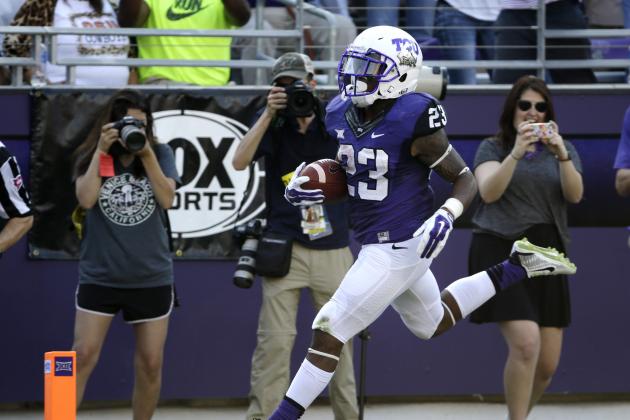
Catalon did not want to make that decision.
The running back declared for the 2015 NFL Draft because he knew another concussion in college could end his career. He went undrafted, and while he was invited to work out for a few teams, he didn’t make a final roster.
He returned to TCU to continue working on his degree with plans to try out for teams again in 2016. In October, he signed a contract with the Winnipeg Blue Bombers of the Canadian Football League.
“I don’t believe football is done,” Catalon said. “I know I’ve still got some more in me.”


